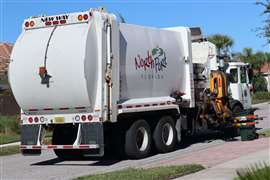Read this article in Français Deutsch Italiano Português Español
Kenworth’s Class 8 T680 FCEV on track for 2025 production
22 April 2024
The company said fuel cell electric vehicles (FCEV) could help fleets meet forthcoming greenhouse gas emissions regulations.
In May 2023, Power Progress reported Kenworth’s plans to produce a Class 8 fuel cell electric vehicle (FCEV). The zero-emissions T680, which will be powered by hydrogen fuel cell technology from Toyota, will be delivered initially to customers this year, with series production planned for 2025. According to Kenworth, the company is largely adhering to that timeline.
“We expect a few initial pilot builds this year, but the substance of our customer-intended production will still take place beginning in late 2025,” said Sarah Abernethy, powertrain marketing manager for Kenworth, in an email to Power Progress.
 The Kenworth T680 FCEV. (Photo: Kenworth)
The Kenworth T680 FCEV. (Photo: Kenworth)
With a 450-mile range, the T680 FCEV is designed for regional haul operations, Kenworth said in its press release announcing the vehicle.
Given the U.S. Environmental Protection Agency’s (EPA) final Phase 3 rules about greenhouse gas (GHG) emissions for heavy-duty trucks, which will first affect model year 2027, Abernethy believes the T680 FCEV will be positively received.
“The EPA’s final Phase 3 rules make a great case for why customers should be exploring hydrogen fuel cell technology for their fleets, alongside battery electric vehicles (BEV) to meet their fleet needs,” she said. “The impact on the GHG side largely falls upon the OEMs, which means that we will continue to develop our zero emissions technologies to ensure we have as many technologies and configurations as possible to meet the broad range of needs across the country for our customers. As of today, the T680FCEV remains our flagship hydrogen fuel cell vehicle, but we are working on additional battery electric vehicles for release in the near term, as well.”
One challenge with more widespread adoption of the T680 FCEV is the availability of hydrogen fuel. According to the Alternative Fueling Station Locator published by U.S. Dept. of Energy’s (DOE) Alternative Fuels Data Center, all 56 retail hydrogen fueling stations in the U.S. — as well as all active hydrogen fuel corridors — are located in California. Including Canada brings the total to 62 fueling stations.
According to Abernathy, Kenworth and parent company Paccar are both working to encourage adoption of hydrogen and the expansion of infrastructure to support it throughout the contiguous United States.
“Kenworth and Paccar are working with Toyota and our T680 FCEV deposit holders closely to help work through the infrastructure needs where they intend to operate,” she said. “While we do have a bit of time before many of these deliveries, that time is precious to ensure that customers and fuel providers are linked up prior to taking delivery.”
In a March report, Power Progress said U.S. Dept. of Transportation data showed pending hydrogen fuel corridors in 30 states beside California. According to the Federal Highway Administration, an active hydrogen fuel corridor must have hydrogen fueling facilities at 100-mile intervals along the corridor’s route.
|
POWER SOURCING GUIDE
The trusted reference and buyer’s guide for 83 years
The original “desktop search engine,” guiding nearly 10,000 users in more than 90 countries it is the primary reference for specifications and details on all the components that go into engine systems.
Visit Now
STAY CONNECTED




Receive the information you need when you need it through our world-leading magazines, newsletters and daily briefings.
CONNECT WITH THE TEAM















